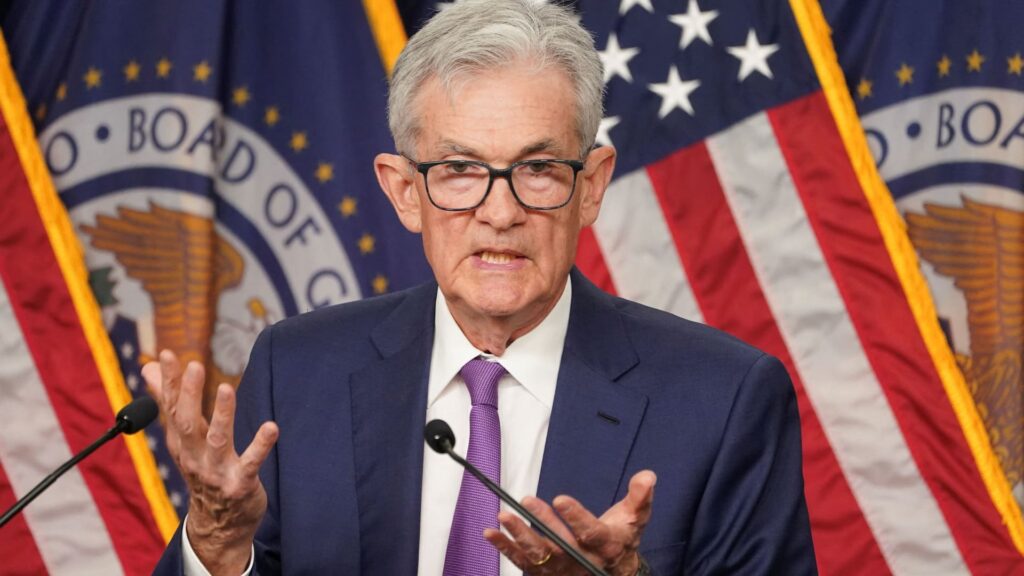
The Federal Reserve on Wednesday kept its key interest rate unchanged and signaled that only one rate cut is expected before the end of the year.
As markets hoped for a more accommodative central bank, Federal Open Market Committee policymakers ruled out two of the three rate cuts outlined in March after their two-day meeting. The committee also made it clear that it believed that the long-term interest rate was higher than previously indicated.
New forecasts released after a two-day meeting this week indicate slight optimism that inflation remains on track toward the Fed’s 2% target, allowing for some policy easing later this year.
“Inflation has decreased over the past year, but remains high,” the statement said following the meeting, echoing the wording of the previous statement. The only significant change was that the new statement said: “Recent months have seen modest further progress towards achieving the Committee’s inflation target of 2 percent.”
The previous formulation stated that there was “no further progress” on inflation.
Traders appeared encouraged by the comments, with the S&P 500 jumping to a record high on Wednesday after the statement was released.
Aggressive reduction expected in 2025
For the period through 2025, the committee now sees five overall cuts equal to 1.25 percentage points, down from six in March. If forecasts come true, the benchmark federal funds rate will remain at 4.1% by the end of next year.
Another important development occurred with the outlook for long-term interest rates, essentially a level that neither stimulates nor limits growth. The figure increased from 2.6% to 2.8%, indicating that the idea that the rate is “higher and longer” is gaining traction among Fed officials.
In another sign of central bankers’ hawkish sentiment, the scatter plot showed four officials favoring no cuts this year, compared with two previously.
Return to 2% target
Elsewhere in the FOMC’s Summary of Economic Forecasts, participants raised their 2024 inflation forecast to 2.6%, or 2.8% excluding food and energy. Both inflation forecasts were 0.2 percentage points higher than in March.
The Fed’s preferred inflation gauge is the Commerce Department’s Personal Consumption Expenditures Price Index, which showed respective readings of 2.7% and 2.8% in April. The Fed is focusing more on core inflation as a better long-term indicator. The SGP indicates that inflation will return to the 2% target, but not before 2026.
The decision and the unofficial forecasts of the 19 meeting participants came in a volatile year for markets and investors’ hopes that the Fed would begin easing policy after raising benchmark rates to their highest level in about 23 years.
The federal funds rate, which determines banks’ overnight borrowing costs but is factored into many consumer debt products, is set at 5.25%-5.50%, the result of 11 rate hikes between March 2022 and July 2023.
Earlier in the day, as Fed officials were preparing their forecasts for the economy and interest rates, the Bureau of Labor Statistics released the consumer price index for May. The report showed that inflation remained unchanged for the month, while the annual rate fell from April to 3.3%. Â
During the press conference, Powell said the report was better than anyone expected and was taken into account in the FOMC’s decision.
“We view today’s report as progress and, as you know, confidence-building,” Powell said. “But we don’t believe we have the confidence to justify starting to ease policy at this time.”
Inflation remains well above the Fed’s 2% target but well below the peak of just over 9% seen nearly two years ago. The core figures, excluding food and energy prices, were 0.2% from the previous month and 3.4% from the year-ago period.
Economic data softened in the first quarter of 2024 compared to most of the previous year, with GDP growing at just 1.3% year on year. Data for April and May were mixed, but the Atlanta Fed is tracking GDP growth at 3.1%, a solid pace, especially in light of persistent recession fears that have dogged the economy over the past two years.
However, the inflation data proved equally resilient and created problems for central bankers.
The year began with markets expecting a strong pace of rate cuts, but that was thwarted by persistent inflation and Fed officials saying they were not convinced inflation was convincingly returning to target.
“This is a rubbish Fed meeting. They know conditions are improving, but they don’t need to rush to cut rates,” said David Russell, global head of market strategy at TradeStation. “A strong economy allows Jerome Powell to push inflation out of the system without hurting jobs. Goldilocks is emerging, but politicians don’t want to jinx it.”


